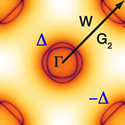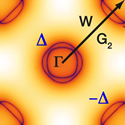Nodes or no nodes
In iron-based superconductors, the existence of nodes in the superconducting gap and the symmetry of the order parameter are topics of considerable debate. The Fermi surface in these materials consists of hole pockets at the center of the Brillouin zone and electron pockets at the zone corners. Many experiments suggest that the symmetry of the superconducting gap is s-wave-like and changes sign between the electron and hole pockets. While s-wave symmetry is not usually associated with nodes, accidental nodes can occur due to a modulation of the gap on the electron pockets. Thus far, angle-resolved photoemission spectroscopy (ARPES) has succeeded in determining the superconducting gap on the hole Fermi surface but cannot resolve the two gaps on the electron pockets to see whether there are nodes.
Writing in Physical Review B, Saurabh Maiti and Andrey Chubukov at the University of Wisconsin in Madison, have made a connection between the measured gap on the hole Fermi surface and the possible presence of the superconducting gap nodes on the electron Fermi surface. The study is based upon a model that considers an angle-dependent interaction between the electron and hole Fermi pockets. Maiti and Chubukov are able to predict the possibility of the absence or presence of gap nodes on the electron Fermi surface based solely upon whether the ratio of the measured gap on the hole Fermi surface and the superconducting transition temperature is above or below a certain threshold. This study might be useful in classifying the nodal behavior of the growing zoo of iron superconductors. – Hari Dahal





